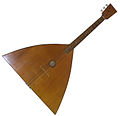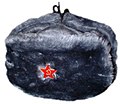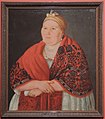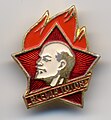User:Czuni6/sandbox
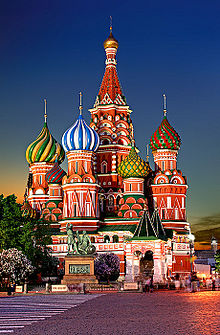
Tourism in Russia has seen rapid growth since the late Soviet times, first inner tourism and then international tourism as well. Rich cultural heritage and great natural variety place Russia among the most popular tourist destinations in the world. Not including Crimea, the country contains 23 UNESCO World Heritage Sites, while many more are on UNESCO's tentative lists.[1]
Major tourist routes in Russia include a travel around the Golden Ring of ancient cities, cruises on the big rivers including the Volga, and long journeys on the famous Trans-Siberian Railway. Diverse regions and ethnic cultures of Russia offer many different foods and souvenirs, and show a great variety of traditions, including Russian banya, Nizhny Novgorod Khokhloma and Matryoshka, Tatar Sabantuy, or Siberian shamanist rituals. In 2013, Russia was visited by 33 million tourists, making it the ninth-most visited country in the world and the seventh-most visited in Europe.[2]
MAP OF LOCATION[edit]

BACKGROUND:[edit]
Land and Climate[edit]
Most of European Russia is in the same climate zone as the Baltic states, Belarus, and northern Ukraine. The climate of south-west Russia (the lower Volga, and the area between the Black Sea and the Caspian Sea) is more arid, with hotter summers and shorter winters. The climate of Russia's Far East is similar to that of Hokkaido, Japan and north-east China. The most severe climate is in Siberia where winters are very cold and summers are very hot, and in Russia's Far North where temperatures are always low, with the exception of Murmansk, where the sea never freezes due to the influence of the warm Norwegian Current. The climate of Russia's Black Sea coast is subtropical. Contrary to popular belief, the climate of most popular tourist areas of Russia is not severe and is similar to that of Eastern Europe. The mean temperatures of December, January and February in Moscow are -4°C (25°F), -7°C (19°F), -6°C (21°F) respectively, but colder weather is common. Over the past few decades spells of extremely cold weather (below -20°C/-4°F) in central European Russia have become rare (in the winter 2016/2017, Moscow had temperatures below -20°C only for three days), while the number of wintry days when the temperature is close to or slightly above the freezing point has grown significantly. In coastal areas wintry temperatures can feel somewhat colder than they actually are due to high humidity. Unless you are allergic to the pollen of certain trees and herbs (such as birch, horse chestnut, alder, lilac, cherry tree, ash tree, rowan tree, lime tree, dandelion), the best time for travelling to central European Russia is late spring when the temperatures are pleasant and many trees are in bloom, and early and mid autumn when trees change their colour and it is not cold yet. Summer months are also good except for June in cities in central and south Russia when poplar fluff can be a nuisance, but recently the authorities of many Russian cities have taken action against the fluff by cutting and removing poplar trees and the situation has improved dramatically. Late autumn, winter months, and early spring will be enjoyable if you wear appropriate clothes and shoes. If you are interested in winter activities, in central European Russia it usually begins to snow in late autumn and snowpack usually doesn't melt away completely before early April, although spells of warm weather do occur and snow can temporarily melt away in mid-winter. Ski resorts in mountainous areas have snow throughout the winter season. Central European Russia sometimes experiences cold spells in early May when the temperature can go from +15°C/59°F to the freezing point for a few days.
History[edit]
Russian history has left a lasting influence on the tourism market in Russia and contributes to a lot of its special interest groups, such as cultural tourism, dark tourism, and battlefield tourism.
1682[edit]
Peter the Great left a large and lasting impact on Russia. Prior to his reign, Russia was constantly competing with the Western world to develop a similar way of life, although its efforts were insignificant. Under Peter I, Russia’s culture was revised; there were technological, scientific, and industrial advances; military and education were expanded, and Western dress, grooming and etiquette was instigated among Peter’s subjects. Moreover, Peter I enforced more contacts with European and Western states. To this day, St Petersburg stands as a major tourist attraction because it symbolizes the great and lasting impact Peter I had on Russia.
1905[edit]
Russian revolution of 1905 marks the beginning of the end of the tsar regime in Russian political system.
1914[edit]
World War I: Under Tsar Nicholas, Russia was deeply crippled due to its involvement in the war; increasing economic and military hardship led to a large loss of life and food shortages, which caused the people's resentment of the people against the government.
1917-18[edit]
1917 Russian Revolution: Bolsheviks uprising under Vladimir Lenin, who strongly supported Marxist socialism, turned Russia into a communist country. Tsar Nicholas II and his family were executed, which ended the Romanov rule and the 300 year tsar dynasty. Russian political system continued to undergo different revisions and regimes under significant figures, such as Lenin and Trotsky.
1922[edit]
The formation of the Soviet Union , Union of Soviet Socialist Republics or USSR, under Lenin. Russia, along with 14 other states, then emerged as a new country based on socialist values.
1924[edit]
With the death of Lenin, Joseph Stalin, head of the Communist Party of the Soviet Union, rose to power over the USSR.
World War II[edit]
1939, USSR signs the Non-aggression pact with Nazi Germany, which utterly dissolved in 1941 when Germany invaded USSR territory. Russia then joined forces with the Allies of World War II. The Aftermath of World War II marks the start of the Cold War as the United States, or US, and USSR increased as world powers.
Cold Wars[edit]
From 1947 to 1991, this era marks increasing tensions between the US and USSR, including the race to get man onto the moon and into space, building of the Berlin Wall, the Nuclear Arms Race.
1991[edit]
The Berlin Wall goes down; Germany becomes one state and the USSR is dissolved. Russia emerges as its own sovereign state and the other 14 states become independent nations. International travel and tourism in Russia now growing considerably with the dissolution of the USSR.
THE PEOPLE[edit]
Population[edit]
Russian population is well mixed with up to 200 different ethnic groups. Most Russians choose to live in the western and southern areas of the country to escape the cold, and be next to European economic powers. As of July 2017, the population is 142,257,519. [3]
Government[edit]
The governmental system of the Russian is semi-presidential, run by a president, a prime minister and a cabinet. Today, Russia’s president is Vladimir Putin and Dmitry Medvedev is the prime minister. Both president and prime minister hold office for 6 years.
Economy[edit]
Economy of Russia is somewhat mixed between a market economy and has some government involvement. Currently, Russian economy is facing recession and stagnation. Russia’s geographic extent contributes to its diverse economy and its ability to provide key exports to the world, including petroleum, natural gas, metal and manufacturing mechanical parts and military technologies.[4]
Language[edit]
The language is officially Russian, which is based off of a Cyrillic alphabet. English is limited and more probable to be spoken by some Russians in the larger cities, such as St. Petersburg or Moscow. In addition to the Russian language, there are many other Slavic dialects that are prevalent, such as Tartar and Chechen. Tourists should be aware that Russian language is categorized into formal and informal cases, and in most situations, it is generally considered polite to use the formal case. Additionally, in order for tourists to thoroughly enjoy their visit in Russia, they should have a guide who can communicate with them and the Russian population, or tourists should at least be able to understand and communicate in Russian on a higher level.
Religion[edit]
About 20% of Russian population is Russian Orthodox, which is the predominant religion. Other popular faiths include other Christian faiths, Islam, and Judaism.[5]
Food and Diet:[edit]
Popular Russian dishes include caviar, vatrushka, blini, pelmeni, and soups, such as borsch. While Russians have a variety of food, some of the Russian mainstays include whole grains such as bread or porridge, as well as potatoes, cabbage and pickled vegetables, Kefir, cheese, and fish. There are many restaurants, markets, bars, and factories to visit in Russia, as well as a number of popular American fast food chains here, such as Papa John's Pizza, Burger King, Carl's Jr., Wendy's, Subway, KFC, and McDonald's. [6]
Russian diet consists of 3 meals a day, and feature whole grains, vegetables, and proteins. Breakfasts typically range from 7 to 8:30 am, lunch from 1:00 to 2:00 pm, and dinner is around 6:30 to 8:00 pm. Lunch is a three-course meal consists of a soup, followed by the main meal, with tea and dessert at the end. Tourists should be aware that there are very few water fountains in public places. It is not recommended to drink tap water in Russia, but it is permissible. More often, kvass (a nonalcoholic beer made from fermented bread), milk, soft drinks or tea are more available over water.
Russian food items that attract foreigners include vodka and caviar, honey, blini, pelmeni, shchi soup and other products and dishes of Russian cuisine.
-
Syrok (cottage cheese covered in chocolate)
Customs and Courtesies[edit]
Greeting customs: Russians give a confident air; they give firm, strong handshakes and maintain eye contact with each other. Women will kiss each other three times alternating on the cheeks. Courtesies: When entering a house, guests are expected to remove their shoes and hosts will often provide slippers or socks for their visitors; guests should bring their own socks however. It is also good manners and expected for guests to bring a small gift for their hosts.
Major National Holidays and Celebrations[edit]
for a full list see Public holidays in Russia
- New Year's Eve, 31 December
- Orthodox Christmas, 7 January
- Maslenitsa, in February or March, in the week before the Lent (according to the Julian calendar)
- Orthodox Easter, in spring after the Lent (according to the Julian calendar)
- Victory Day, 9 May
- Day of Slavic Alphabet and Culture, 24 May
- Day of Russia, 12 June
- Ivan Kupala Day, 7 July
- Day of the Christianization of Rus', 28 July
- Russian Navy Day, the last Sunday of July (major celebrations include naval parades in St Petersburg and Vladivostok)
- Day of People's Unity, 4 November
- Defender of the Fatherland Day, 23 February
Major Events[edit]
- 2018 FIFA World Cup, 14 June to 15 July 2018
- Honey Fair in Kolomenskoye, February - March, an annual honey festival in Kolomenskoye, Moscow
- KHL Conference Finals and the Gagarin Cup, March and April, final series of the Kontinental Hockey League
- Kinotavr Film Festival, June, an international film festival in Sochi
- Scarlet Sails Festival, on a Saturday in the second half of June, annual celebration in St Petersburg marking the end of school year
- International Tchaikovsky Competition, 10-30 June, an annual international competition in Moscow, final gala concerts 2-3 July in Moscow and St Petersburg
- MAKS Air Show, July, an annual international aerospace show in Zhukovsky, Moscow Region
- Silk Way Rally, July
- Sabantui, on a Sunday in summer, a major holiday celebrated primarily in Tatarstan and Bashkortostan
- Spasskaya Tower (Festival), the last week of August, the first week of September, an annual international military music festival in Red Square, Moscow
- Kurban Bairam, August or September, the local name of Eid al-Adha celebrated primarily in Tatarstan, Bashkortostan, North Caucasus and by Muslim communities in major cities
- Chereshnevy Les Festival, summer, an international annual open-arts festival in Moscow
- Okno v Yevropu, 6-12 August, an annual Russian film festival in Vyborg, Leningrad Region
- Moscow International Film Festival, an international biennial film festival in Moscow
- City Day in Moscow, first Saturday of September, an annual celebration marking the birthday of Moscow
- Borodino Day, first Sunday of September, an annual event in memory of the Battle of Borodino, includes historical re-enactment, in Borodino, Moscow Region
- Moscow Fashion Week, 24-29 October, an annual fashion event in Moscow
- The Moscow Biennale of Contemporary Art, dates vary, a biennial event that started in 2003
TOURISM:[edit]
Visa/Entry Requirements[edit]
The citizens of CIS member states, most Latin American countries, Israel and South Africa, can travel in Russia for a 90 days without a visa; visitors from South Korea can visit Russia for 60 days without a visa; while tourists from Bosnia and Herzegovina, Cuba, Laos, Macau, Macedonia, Mongolia, Montenegro, Serbia, Seychelles and Thailand, can visit for 30 days without a visa.
Free e-visas for visiting three regions in Russia's Far East (Primorye, Sakhalin, and Kamchatka) are availabale for tourists from China, Japan, India, Iran, Turkey, Morocco, Mexico, and some other countries.
Tourists from other countries are required to visit a Russian diplomatic mission to purchase a visa. Tourists are required to have a valid passport when crossing the Russian border. Russian visas cannot be purchased at the border. For more information see visa policy of Russia.
Currency Conversion[edit]
Russians currency is the ruble. Country currency converted in United States Dollars, Canadian Dollar, Euros, Pounds, and Yens, as follows:
- USD: $1 = 56.69 RUB
- CAD: $1 = 43.92 RUB
- EURO: €1 = 70.39 RUB
- British Pounds: £1 = 79.0401 RUB
- Yens: ¥1 = 0.54 RUB
Key Tourism Development[edit]
Hotels, hostels, and Airbnbs are available in Russia only for visitors who have visas. Russian summer houses, or dachas are also available for rent. There are also a number of both state and private-run hospitals in Russia, including China-Russia International Medical Emergency Cooperation Hospital and health care is based on the patient's insurance.
Must See Attractions[edit]
Cultural Tourism[edit]


The most popular tourist destinations in Russia are Saint Petersburg (which appeared in the list of top visited cities of Europe in 2010) and Moscow, the current and the former capitals of the country and great cultural centers, recognized as World Cities. Moscow and Saint Petersburg feature such world-renowned museums as Hermitage and Tretyakov Gallery, famous theaters including Bolshoi and Mariinsky, ornate churches such as Saint Basil's Cathedral, Cathedral of Christ the Saviour, Saint Isaac's Cathedral and Church of the Savior on Blood, impressive fortifications such as Moscow Kremlin and Peter and Paul Fortress, beautiful squares such as Red Square and Palace Square, and streets such as Tverskaya and Nevsky Prospect. Rich palaces and parks of extreme beauty are found in the former imperial residences in the suburbs of Moscow (Kolomenskoye, Tsaritsyno) and Saint Petersburg (Peterhof, Strelna, Oranienbaum, Gatchina, Pavlovsk Palace, Tsarskoye Selo). Moscow contains a great variety of impressive Soviet-era buildings along with modern skyscrapers, while Saint Petersburg, nicknamed Venice of the North, boasts its classical architecture, many rivers, channels and bridges.

Nizhny Novgorod is the capital of the Volga region. It is considered to be "younger brother" of Moscow. Because it has its own Kremlin, the metro, the so-called "Nizhny Novgorod Arbat" (Bolshaya Pokrovskaya Street) and even a copy of the monument to Minin and Pozharsky, the original of which is in the Russian capital. Nizhny Novgorod is divided into two parts by the Oka River. The Upper City is its historical part. Here are the Kremlin, Minin and Pozharsky Square, Bolshaya Pokrovskaya and Rozhdestvenskaya streets, nightclubs, open spaces, a large number of monuments and simply historical places. The Lower City is its industrial and commercial part. Here are the Fair, the old Sormovo and Kanavino, GAZ and Sotsgorod (the so-called "city in the city"), the railway terminal, the airport and many attractions for people who want to see the styles of underground, industrial and grunge. The city is the main starting point for cruises along Volga River. From here begins shipping to Moscow and St. Petersburg.
Kazan, the capital of Tatarstan, shows a unique mix of Christian Russian and Muslim Tatar cultures. The city has registered a brand The Third Capital of Russia, though a number of other major Russian cities compete for this status, including Nizhny Novgorod, Novosibirsk, Yekaterinburg and Samara, all being major cultural centers with rich history and prominent architecture. Veliky Novgorod, Pskov, Dmitrov and the cities of Golden Ring (Vladimir, Yaroslavl, Kostroma and others) have at best preserved the architecture and the spirit of ancient and medieval Rus', and also are among the main tourist destinations. Many old fortifications (typically Kremlins), monasteries and churches are scattered throughout Russia, forming its unique cultural landscape both in big cities and in remote areas.
Sakha Republic proposes to use former forced labour camps as a tourist attraction.[7] Poles visit places of Communist crimes, e.g. of the Katyn massacre and Solovetsky Islands.[8][9]
Notable Museums[edit]
Russia enjoys a rich cultural heritage and is home to many museums. The most notable include the Tretyakov Gallery, the Kremlin Armoury and the State Historical Museum in Moscow, the Hermitage Museum, the Russian Museum, and the Central Naval Museum in St Petersburg, the Kazan Kremlin in Kazan, the Battle of Stalingrad Museum, etc. Russia is also famous for having many museums related to its literary and classical music heritage, such as Yasnaya Polyana (Leo Tolstoy), the Mikhaylovskoye Museum Reserve (Alexander Pushkin), the Dostoyevsky Museum, the Tchaikovsky State House-Museum. the Rimsky-Korsakov Apartment and Museum, the Mikhail Glinka Museum in Moscow, the Sergei Rachmaninoff Estate Museum in Ivanovka, Tambov Region, the Alexander Scriabin Apartment Museum in Moscow.
Secondary Attractions[edit]
Resorts and nature tourism[edit]


The warm subtropical Black Sea coast of Russia is the site for a number of popular sea resorts such as Sochi, known for their beaches and wonderful nature. At the same time Sochi can boast a number of major ski resorts, such as Krasnaya Polyana. The city was the host of 2014 Winter Olympics. The mountains of the Northern Caucasus contain many other popular ski resorts, such as Dombay in Karachay–Cherkessia.

The most famous natural tourist destination in Russia is Lake Baikal, named the Blue Eye of Siberia. This unique lake, oldest and deepest in the world, has crystal-clean waters and is surrounded by taiga-covered mountains.
Other popular natural destinations include Kamchatka with its volcanoes and geysers, Karelia with its many lakes and granite rocks, Altai with its snowy mountains and Tyva with its wild steppes, Republic of Adygea for Fisht Mountain, Chechnya Republic for Lake Kezenoyam and Republic of Karelia for Ruskeala Canyon.[10]
The Seven Wonders of Russia, the most popular tourist destinations chosen in a national vote in 2008, include Lake Baikal, Valley of Geysers, Manpupuner rock formations, and Mount Elbrus.
The most famous national parks and sanctuaries of Russia include the Transbaikal National Park, the Altai Nature Reserve, the Lazovsky Nature Reserve, the Kedrovaya Pad' Nature Reserve, the Samarskaya Luka National Park, the Smolenskoye Poozerye Nature Reserve, the Curonian Spit Nature Reserve, the Valdai National Park, the Baikal-Lena Nature Reserve, the Ilmen Nature Reserve.
Since 2014, the following tourist destinations in Crimea are under occupation of the Russian Federation:
- Yalta — a health resort on Black Sea, where the post-World War II Yalta peace conference took place.
- Sevastopol — a federal city on the Black Sea coast.
- Simferopol — the capital of the Republic of Crimea, on the Salhir River. It is a manufacturing, commercial, and transportation centre located in a productive agricultural region.
Souvenirs[edit]
Typical souvenirs include the Matryoshka doll and other handicraft, samovars for water heating, ushanka and papaha warm hats, and fur clothes among other items.
-
Birch bark souvenirs
-
Russian shawl
-
Soviet-era souvenirs
Tourism Transportation Options[edit]
For security reasons, Russian ticket offices sell tickets for trains, airplanes and coaches only if you show your passport[11].
Railways[edit]
The state-owned company Russian Railways (abbreviated as РЖД) operates most of rail services across the country and is crucial for the rail transport in Russia. High-speed rail services are available between Moscow and St Petersburg, between Moscow and Nizhny Novgorod, and between St Petersburg and Helsinki (Finland). European Russia and the Russian Far East are connected by rail via the Trans-Siberian Railway. A train trip from Moscow to Vladivostok takes 6 days.[12] Russia uses the 1,524mm (5ft) track gauge, which is also shared by all the former Soviet republics (Estonia, Latvia, Lithuania, Belarus, Ukraine, Georgia, Armenia, Azerbaijan, Kazakhstan, Turkmenistan, Tajikistan, Uzbekistan, Kyrgyzstan), Mongolia, and is practically identical with the rail gauge of Finland. Trains crossing the border between Russia (Belarus, Ukraine) and EU member states (except the Baltic states and Finland) or between Russia and China, stop at special crossing points where each carriage is lifted for its bogies to be changed. Trains remain at crossing points for up to 2 hours.[13]
Sea and river transport[edit]
Russia's major sea ports Category:Port cities and towns in Russia include St Petersburg and Kaliningrad on the Baltic coast; Murmansk and Arkhangelsk on the Arctic coast; Vladivostok, Yuzhno-Sakhalinsk, and Petropavlovsk-Kamchatsky on the Pacific coast; Sochi, Novorossiysk, and Sevastopol on the Black Sea coast; Astrakhan on the Caspian coast. In European Russia, many river boat companies offer journeys to cities and towns on the Volga River, its tributaries and connected canals: Moscow (via the Moscow Canal), Yaroslavl, Kostroma, Nizhny Novgorod, Kazan, Saratov, Volgograd, Astrakhan. River boats from St Petersburg can travel to Staraya Ladoga and Veliky Novgorod on the Volkhov River, to Ladoga Lake, and to Moscow (via canals).[14]
Air transport[edit]
Russia's busiest international airports are situated near Moscow, St Petersburg, Volgograd, Kazan, Krasnodar, Sochi, and Vladivostok. For more information see a list of airports in Russia. Moscow and Saint Petersburg are served by direct flights from most European capitals, and Moscow also has direct flights from any cities in East Asia, South Asia, Africa, the Middle East, and North America.[15] Countries that have no direct flights to Russia include Australia,[16] Canada[17] and Ukraine.[18]
Roads[edit]
Major national thoroughfares are known as federal highways. For more information see Russian federal highways. Most of highways are toll-free, however recently there have opened a few toll roads.[19] Usual roads in smaller Russian cities and in the countryside can be in bad condition.[20] During the cold season (from November till April), when there is permanent snowpack and ice on the roads, winter tyres are mandatory.[21]
Public transport in major cities[edit]
Russian cities that have a metro include Moscow, St Petersburg, Nizhny Novgorod, Novosibirsk, Samara, Yekaterinburg, Kazan.[22] Entrances to metro stations are marked using the letter M which looks the same in the Russian and Roman alphabets. On the Moscow Metro, announcements on trains are made in Russian and English, and direction signs and maps often include English.[23] Apart from buses and trams, trolleybuses are a very common means of overground transport in Russian cities. For more information see the list of trolleybus systems in Russia. Another widely used means of public transport is marshrutkas, or shared taxies. If you are going to visit Moscow and use public transport, see the article about the Troika card (a similar card known as Podorozhnik is used in St Petersburg). Taxi services available in major Russian cities include Yandex.Taxi, Uber (company), and Gett.
Tourism Safety and Security[edit]
Environmental Concerns[edit]
Natural disasters[edit]
Natural hazards of central European Russia include hurricanes, thunderstorms, and spring floods when snowpack accumulated during the winter melts away; south Russia sometimes experiences flash floods. Earthquakes do not occur in Russia except for mountainous areas in the south (the Caucasus Mountains, the Altai Mountains) and the Pacific coast. Forest fires can occur in hot summers, especially in south Siberia.
Dangerous animals[edit]
Big wild animals such as bears and wolves are common in parts of Siberia and Russia's Far East, they also inhabit some thick forests north and east of Moscow in European Russia; female bears can be especially dangerous when they have cubs, while male bears are especially dangerous if they wake up and roam in wintertime; wolves are dangerous in the winter period. The only poisonous snake in central European Russia is the viper; it mainly inhabits boggy and marshy forests but can occasionally be met in other types of forests, so high boots are advisable for forest trips and hikes. Tick-borne encephalitis is another hazard that is associated with forests and parks in Russia. Animals that are most prone to rabies are stray dogs and cats, wild foxes, wolves, hedgehogs, raccoon dogs.
Environmental contamination[edit]
A certain level of radioactive contamination (corresponding to that of central Austria and central Sweden) caused by rains following the Chernobyl disaster is found in some parts of Bryansk Region and Tula Region, western Leningrad Region, and south-east Sverdlovsk Region. High levels of industrial contamination are found in the city of Norilsk and in Chelyabinsk Region and Sverdlovsk Region.
Socio-Cultural Concerns[edit]
Militant groups[edit]
Most regions of Russia are safe, however travels to some areas in North Caucasus can pose a certain risk, especially parts of Chechnya and Dagestan.
Emergency Contacts[edit]
Emergency services, similar to the North American Numbering Plan for emergencies, 911, is 112. There are about 111 Foreign Embassies and 86 Consulates placed in the territory of Russia. Russia itself in total counts near 140 Embassies and 37 Consulates spread all over the world.
Foreign travel statistics[edit]
In 2013, 27 million international tourists arrived in Russia, generating US$11.2 billion in international tourism revenue for the country.[24] Including domestic and international tourism, the industry directly contributed RUB860 billion to the Russian GDP and supported 966,500 jobs in the country.[25]
See also[edit]
- Visa policy of Russia
- Russian culture
- List of museums in Russia
- List of World Heritage Sites in Russia
- Moscow Underground
- Wildlife of Russia
References[edit]
- ^ "UNESCO World Heritage Centre - Tentative Lists". Whc.unesco.org. Retrieved December 16, 2017.
- ^ ""Tourism Highlights 2014"" (PDF). E-unwto.org. Retrieved December 16, 2017.
- ^ https://www.cia.gov/library/publications/the-world-factbook/geos/rs.html
- ^ https://www.cia.gov/library/publications/the-world-factbook/geos/rs.html
- ^ Central Intelligence Agency Wolrd Fact Book: Central Asia: Russia
- ^ http://www.world-food.ru/en-GB/press/news/3081.aspx.
- ^ Luhn, Alec (March 26, 2014). "Russia's Sakha Republic proposes 'tourist camps' on former gulag sites". The Guardian.
- ^ "Strona domeny katyn.pl". Katyn.pl. Retrieved December 16, 2017.
- ^ Itaka, Biuro Podróży. "Tajemnice Wysp Sołowieckich - ITAKA". Itaka.pl. Retrieved December 16, 2017.
- ^ "40 most beautiful places in Russia". Russianblogger.me. Retrieved September 30, 2015.
- ^ "Travel by Train 101: Everything You Need to Know About Travelling by Train in Russia". Trainsrussia.com. Retrieved December 16, 2017.
- ^ "Moscow Vladivostok train tickets at discount prices. Rossiya train. Free Schedules and Timetables. Take the Trans Siberian Express with us today and save". Transsiberianexpress.net. Retrieved December 16, 2017.
- ^ "Faster through railway border crossing – Visit Belarus!". Visitbelarus.eu. Retrieved December 16, 2017.
- ^ "Russian River Cruises & Tours 2017, Best River Trips & Cruises to Russia (St Petersburg)". Russian-river-cruises.com. Retrieved December 16, 2017.
- ^ "Russia – Travel guide at Wikivoyage". En.wikivoyage.org. Retrieved December 16, 2017.
- ^ "Found the cheapest flights to Russia". Skyscanner.com.au. Retrieved December 16, 2017.
- ^ "Aeroflot Cancels Flights To Canada". Huffington Post. October 3, 2014. Retrieved December 16, 2017.
- ^ Rainsford, Sarah (October 24, 2015). "Russia and Ukraine to ban direct flights". Bbc.com. Retrieved December 16, 2017.
- ^ "Russia 2018 - Fan guide - Free and toll roads". Welcome2018.com. Retrieved December 16, 2017.
- ^ [1] [dead link]
- ^ "Winter Tyre Laws". Continental-tires.com. Retrieved December 16, 2017.
- ^ "Metro Systems In RUSSIA - Metro systems of the World". Sites.google.com. Retrieved December 16, 2017.
- ^ "All metro stops in Moscow now announced in Russian and English / News / Moscow City Web Site". Mos.ru. April 27, 2017. Retrieved December 16, 2017.
- ^ "Tourism Highlights 2013 edition" (PDF). Dtxtq4w60xqpw.cloudfront.net. Retrieved November 27, 2013.
- ^ "2013 Travel & Tourism Economic Impact Report Russian Federation" (PDF). Wttc.org. Retrieved November 27, 2013.
External links[edit]
- Moscow City Guide at the official website of the Mayor of Moscow(in English)
- St Petersburg Official City Guide(in English)
- Karelia Tourist Portal (Solovetsky Islands, Kizhi)(in English)
- Guide to the Golden Ring of Russia(in English)
- Tatarstan Official Guide(including Kazan)(in English)
- Official Rosa Khutor Guide (ski resorts in Sochi)(in English)
- Baikal Tourist Guide(in English)
- Vladivostok City Guide(in English)
- Russia Travel Guide(in English)
- Russia travel and tourism at Curlie
- Fully Personalized Itineraries for independent travel in Russia
- Representing in North America: Russian National Tourist Office
- (in English and Russian) Federal Agency for Tourism
- Russia Beyond the Headlines news portal









